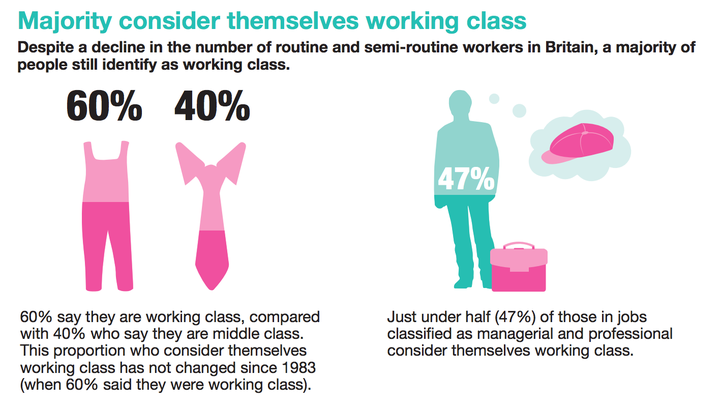
Class divide is "alive and well" thanks to years of austerity, a major report has found while warning it may explain the "disaffection" that fuelled 'Brexit'.
The National Centre For Social Research, which examined class, public spending and the workplace since 2010, said that the proportion of people that see themselves as working-class is the same level as in 1983 despite the decline in traditional industry.
Researchers found a "working class of the mind" leads to holding views that are "less libertarian and less pro-immigrant" but "not necessarily more left-wing". Its survey concluded austerity has "sharpened" the perception that it is hard to move up the social ladder.
The report appears to underpin many of the factors that commentators think contributed to the 'Brexit' vote, including a protest vote aimed at the political elite, fears over immigration and Labour's failure to connect with its core vote.
It found:
Most people think they are working class

Some 60% of people describe themselves as working class compared with 40% who say they are middle class - the same as in 1983. Almost half of people in professional and managerial occupations say they are working class.
People who identify as working class are more likely to believe in a class divide

People who identify as working class (82%) are more likely than those who say they are middle class (70%) to believe the divide between social classes is wide.
"People who see society as divided between a large disadvantaged group and a small privileged elite feel more working class regardless of their actual class position," the report says.
More people believe it is difficult to move between classes than a decade ago
Nearly three-quarters (73%) believe it is fairly or very difficult to move between classes, compared with 65% who held this view in 2005.
The report goes on that people who identify as working class are more likely than those who say they are middle class to think moving between classes is very difficult.
Class identity is closely linked to attitudes
'Occupationally middle class' people - who feel they are working class - do not differ in their attitudes towards the economy from other middle class people, but are much more like the working class on immigration and social issues.
Some 69% of people in 'routine and semi-routine occupations' hold anti-immigrant views, it says, while a majority of those in 'professional and managerial occupations' (54%) are pro-immigration.

University of Oxford academics Geoffrey Evans and Jonathan Mellon explain while John Prescott announced in 1997 that "we’re all middle class now", the decline in the number of manual workers in Britain today is "only part of the picture".
They say:
"There is another working class: what we might call the working class of the mind. There is a big difference between being working class as defined by officials and social scientists in terms of occupation and being working class as defined by people themselves."
Evans and Mellon go on that those identifying themselves as working class despite being employed in middle class occupations is more pronounced if their family background was working class or they have never been to university.
They say:
"And this sense of working class identity apparently means that they are less libertarian and less pro-immigrant, but not necessarily more left-wing - even though those with a working class identity are particularly likely to think that class differences and barriers remain important."
Kirby Swales, director of NatCen’s Survey Centre, said: “The class divide is alive and well in Britain and the economic instability and austerity of recent years seem to have sharpened our belief that it is difficult to move from one class to another.
"Class divisions have been highlighted recently with the vote to leave the EU with some commentators talking about disaffection among the working class. Our findings certainly show that people who believe themselves to be working class are more likely to believe in a class divide than those who say they are middle class and more think it is difficult to move between classes than did in the past.
"Class identity is also closely linked to attitudes in other areas. Those who say they are working class are far more likely to be opposed to immigration, one of the defining issues of the EU referendum, even when they are in professional and managerial jobs.”
